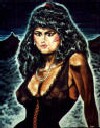 Female warriors who live on the fringes of the Greek world, the Amazons play a part in the stories of several heroes, as well as in the Trojan War. Historically, Amazons were portrayed as beautiful women in Amazonomachies, which was an artform portraying battles between the Amazons and the Greeks. Amazons were trained to use all weapons, especially in single combat. They were honorable, courageous, brave and represented rebellion against sexism.
Female warriors who live on the fringes of the Greek world, the Amazons play a part in the stories of several heroes, as well as in the Trojan War. Historically, Amazons were portrayed as beautiful women in Amazonomachies, which was an artform portraying battles between the Amazons and the Greeks. Amazons were trained to use all weapons, especially in single combat. They were honorable, courageous, brave and represented rebellion against sexism.
BACK
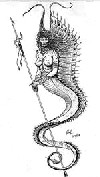 Legendary for luring sailors by singing their enchanted songs, Sirens rest in a meadow piled high with the smoldering skeletons of men, withered skin still hanging upon the bones. The Sirens bewitch everybody who approaches them with their high clear song. In Greek mythology, the Sirens were represented with the head and bust of a woman and the body of a bird, and only later were they depicted as women whose bodies terminated in fish tails (mermaids). Their attribute was a musical voice, or instrument like a lyre or a double flute. With a temple in Sorrento, they lived on an island (Sirenum scopuli; three small rocky islands). With the irresistible charm of their musical song they lured mariners to their destruction on the deadly rocks surrounding their island.
Legendary for luring sailors by singing their enchanted songs, Sirens rest in a meadow piled high with the smoldering skeletons of men, withered skin still hanging upon the bones. The Sirens bewitch everybody who approaches them with their high clear song. In Greek mythology, the Sirens were represented with the head and bust of a woman and the body of a bird, and only later were they depicted as women whose bodies terminated in fish tails (mermaids). Their attribute was a musical voice, or instrument like a lyre or a double flute. With a temple in Sorrento, they lived on an island (Sirenum scopuli; three small rocky islands). With the irresistible charm of their musical song they lured mariners to their destruction on the deadly rocks surrounding their island.
BACK
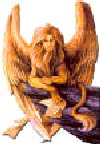 In ancient art the Sphinx is often shown carrying off young men. As a death-bringing snatcher she is comparable to the Harpies. The Sphinx is best known as the riddle-loving monster which terrorized Thebes until Oedipus came along and answered her question correctly.
In ancient art the Sphinx is often shown carrying off young men. As a death-bringing snatcher she is comparable to the Harpies. The Sphinx is best known as the riddle-loving monster which terrorized Thebes until Oedipus came along and answered her question correctly.
BACK
Harpies had female torsos melded with various vulture parts; the name harpy is derived from the Greek word that means "Snatcher." Harpies are composite monsters who are sometimes shown on tombs carrying off the dead.
BACK
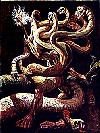 A long time ago, Greek people believed that a long strip of stars was really an image of a gigantic serpent known as the Hydra. The Hydra lived beneath a tree near a swamp, but the people of Lerna were terrorized by this serpent - a horrifying beast with many snake-like heads, one of which was immortal. The heads of the Hydra could grow back even if they were cut off. Anyone approaching the Hydra could also be killed by its venomous breath.
A long time ago, Greek people believed that a long strip of stars was really an image of a gigantic serpent known as the Hydra. The Hydra lived beneath a tree near a swamp, but the people of Lerna were terrorized by this serpent - a horrifying beast with many snake-like heads, one of which was immortal. The heads of the Hydra could grow back even if they were cut off. Anyone approaching the Hydra could also be killed by its venomous breath.
BACK
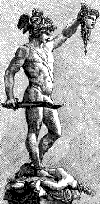 The Gorgon Medusa was once a beautiful Lybian princess whose hair was her chief glory, some said she vied in beauty with Athena. After she was seduced by the ea god Poseidon in the temple consecrated to Athena, the jealous goddess deprived her of her charms and transformed the princess into a monster. With hair changed from beautiful ringlets to hissing serpents, she became so cruel and frightening that no living thing could behold her without being turned into stone.
The Gorgon Medusa was once a beautiful Lybian princess whose hair was her chief glory, some said she vied in beauty with Athena. After she was seduced by the ea god Poseidon in the temple consecrated to Athena, the jealous goddess deprived her of her charms and transformed the princess into a monster. With hair changed from beautiful ringlets to hissing serpents, she became so cruel and frightening that no living thing could behold her without being turned into stone.
BACK
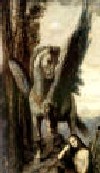 Pegasus was a winged horse created by the sea god Poseidon and the Gorgon Medusa, conceived in Athena's temple before Medusa's body was transformed. After she was beheaded by Perseus, the warrior Chrysaor and the winged horse Pegasus sprang out of her severed neck. Able to fly to and from Mount Olympus, Pegasus transports the thunderbolts forged by the Cyclopses to Zeus.
Pegasus was a winged horse created by the sea god Poseidon and the Gorgon Medusa, conceived in Athena's temple before Medusa's body was transformed. After she was beheaded by Perseus, the warrior Chrysaor and the winged horse Pegasus sprang out of her severed neck. Able to fly to and from Mount Olympus, Pegasus transports the thunderbolts forged by the Cyclopses to Zeus.
BACK
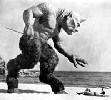 Children of Gaia and Ouranos who are later enlisted by Zeus to forge his thunderbolts, Cyclopses are giants with a single, round eye in the middle of their forehead. According to Hesiod, they were strong, stubborn, and "abrupt of emotion." Their every action ebbed with violence and power.
Children of Gaia and Ouranos who are later enlisted by Zeus to forge his thunderbolts, Cyclopses are giants with a single, round eye in the middle of their forehead. According to Hesiod, they were strong, stubborn, and "abrupt of emotion." Their every action ebbed with violence and power.
BACK